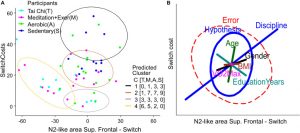Improve Psychological Well-Being in Covid-19 Lockdown with Online Mindfulness Training
By John M. de Castro, Ph.D.
“mindfulness is one tool that can help promote mental wellness throughout the COVID-19 pandemic and beyond.” – Julie Dunn
Mindfulness training has been shown to improve health and well-being in healthy individuals. It has also been found to be effective for a large array of medical and psychiatric conditions, either stand-alone or in combination with more traditional therapies. The COVID-19 pandemic has challenged the mental and physical health of the population. It has created intense stress both for frontline workers but also for people simply isolating at home. Mindfulness is known to decrease the psychological and physical responses to stress. So, mindfulness training may be helpful in coping with the mental and physical challenges resulting from the COVID-19 pandemic.
In today’s Research News article “A Brief Online Mindfulness-Based Group Intervention for Psychological Distress Among Chinese Residents During COVID-19: a Pilot Randomized Controlled Trial.” (See summary below or view the full text of the study at: https://www.ncbi.nlm.nih.gov/pmc/articles/PMC7972025/ ) Zhang and colleagues recruited online Chinese adults who were staying at home during the Covid-19 lockdown. They were randomly assigned to a wait-list control condition or to receive online mindfulness training with an abbreviated group version of Mindfulness-Based Stress Reduction (MBSR). The training consisted of a 2-hour training followed by 13 days of 1.5 hours per day of practice separated into 3 30-minute sessions. Once training was complete for the mindfulness group, the wait-list group received the same 2-week mindfulness training. They were measured before and after the training for mindfulness and psychological distress, including somatization, depression, and anxiety.
They found that in comparison to baseline and the wait-list control group, the mindfulness training produced significantly higher mindfulness levels and significantly lower levels of psychological distress, including somatization, depression, and anxiety levels. The wait-list group after they received the mindfulness training had similar significant improvements in their psychological well-being.
These results are consistent with previous findings that mindfulness training produces decreases in distress, including somatization, depression, and anxiety. But the present study demonstrates that online mindfulness training can produce similar benefits for individuals locked down during a pandemic. Since the training is online, it could be made available to widespread individuals at low cost and thus would be ideal for maintaining the psychological health of people in lock down.
So, improve psychological well-being in covid-19 lockdown with online mindfulness training.
“In many ways, COVID-19 has shown us just how connected and how much the same we really are. All of us—and some of us more than others—are vulnerable to getting sick and none of us wants to become ill. Viewed through the lens of interconnectedness, practicing mindfulness as the coronavirus spreads is not only a way to care for ourselves but a way to care for everyone around us.” – Kelly Barron
CMCS – Center for Mindfulness and Contemplative Studies
This and other Contemplative Studies posts are also available on Google+ https://plus.google.com/106784388191201299496/posts and on Twitter @MindfulResearch
Study Summary
Hui Zhang, Anao Zhang, Chengbin Liu, Jian Xiao, Kaipeng Wang. A Brief Online Mindfulness-Based Group Intervention for Psychological Distress Among Chinese Residents During COVID-19: a Pilot Randomized Controlled Trial, Mindfulness (N Y) 2021 Mar 18 : 1–11. doi: 10.1007/s12671-021-01618-4
Abstract
Objectives
The coronavirus (COVID-19) global pandemic has increased psychological distress among the general population. The objective of this study is to evaluate a mindfulness-based intervention for psychological distress among Chinese residents during COVID-19.
Methods
This study used a switching replications design to test the feasibility and efficacy of a brief online mindfulness-based intervention for Chinese residents’ psychological distress. Fifty-one residents in the Hubei province were randomly allocated to two groups (experimental group and waitlist control group) with three waves of measurement at time 1, time 2, and time 3 for changes in mindfulness and psychological distress.
Results
In addition to significant within-group improvements over time for both groups, OLS linear regression with full information likelihood estimation revealed statistically significant between-group treatment effects across outcome domains, including mindfulness awareness, b = 2.84, p < 0.001, g = 6.92, psychological distress, b = −21.33, p < 0.001, g = 6.62, somatic symptoms, b = −6.22, p < 0.001, g = 4.42, depressive symptoms, b = −7.16, p < 0.001, g = 5.07, and anxiety symptoms, b = −8.09, p < 0.001, g = 6.84.
Conclusions
Results suggest that a brief online mindfulness-based intervention can be a feasible and promising intervention for improving mindfulness and decreasing psychological distress among Chinese residents staying at home during the COVID-19 outbreak. The study used a small convenience sample which led to a concern of external generalizability and with limited evaluation of long-term change.
https://www.ncbi.nlm.nih.gov/pmc/articles/PMC7972025/









